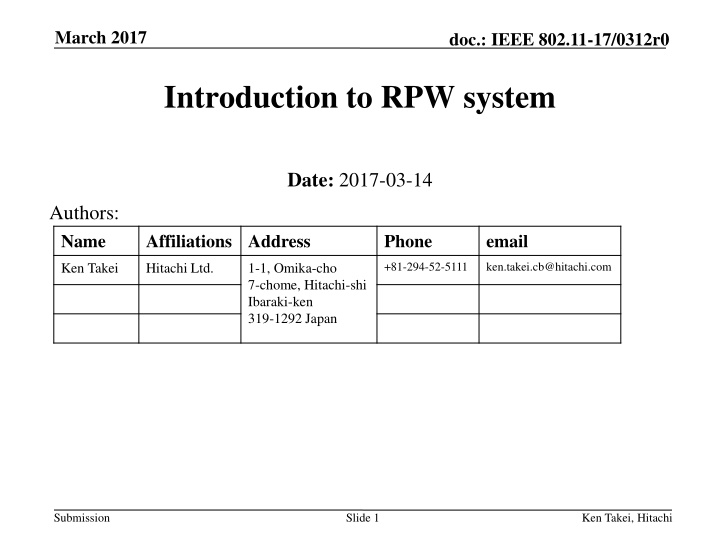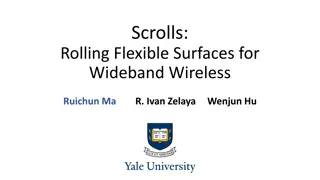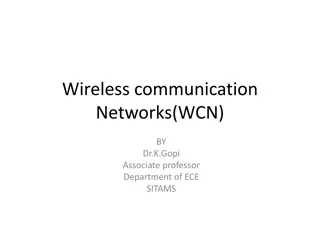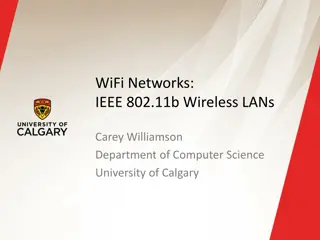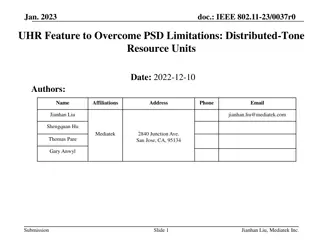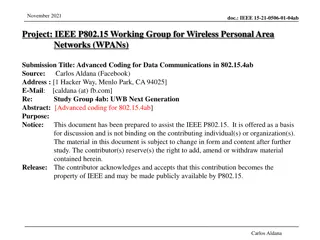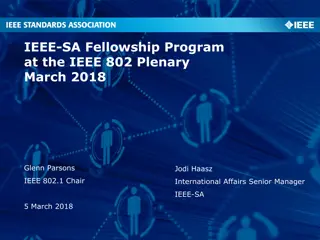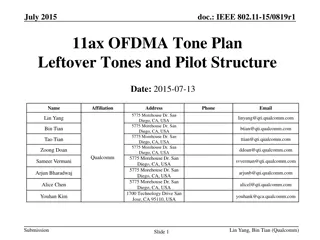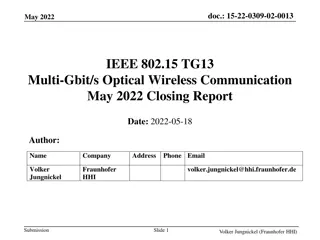Introduction to IEEE 802.11 Wireless Communication System
This document discusses the IEEE 802.11 standard focusing on the Wireless RPW system, cellular communication vs. M2M, wireless links between sensors and gateways, IoT O&M for industrial systems, and solutions using polarization for non-line-of-sight communication. It delves into improving system performance, challenges faced, and proposed solutions for effective communication in various scenarios.
Download Presentation

Please find below an Image/Link to download the presentation.
The content on the website is provided AS IS for your information and personal use only. It may not be sold, licensed, or shared on other websites without obtaining consent from the author.If you encounter any issues during the download, it is possible that the publisher has removed the file from their server.
You are allowed to download the files provided on this website for personal or commercial use, subject to the condition that they are used lawfully. All files are the property of their respective owners.
The content on the website is provided AS IS for your information and personal use only. It may not be sold, licensed, or shared on other websites without obtaining consent from the author.
E N D
Presentation Transcript
March 2017 doc.: IEEE 802.11-17/0312r0 Introduction to RPW system Date: 2017-03-14 Authors: Name Affiliations Address Phone email +81-294-52-5111 ken.takei.cb@hitachi.com Ken Takei Hitachi Ltd. 1-1, Omika-cho 7-chome, Hitachi-shi Ibaraki-ken 319-1292 Japan Submission Slide 1 Ken Takei, Hitachi
March 2017 doc.: IEEE 802.11-17/0312r0 Cellular communication v.s. M2M Submission Slide 2 Ken Takei, Hitachi
March 2017 doc.: IEEE 802.11-17/0312r0 Wireless link between numerous sensors to a gateway and between gateways Wireless link to connect numerous sensors to a gateway Non-Line-of-Sight communication among gateways Highly scattering and no time variation waves are useful Ken Takei, Hitachi Submission Slide 3
March 2017 doc.: IEEE 802.11-17/0312r0 IoT O&M for Industrial System Purpose Improve system performance by monitoring and controlling its equipment With numerous sensors and actuators onto that, respectively Features Wireless link between numerous devices to a gateway and between gateways Non-line-of-sight communication among devices fixed onto scatting surfaces Data of low rate less than 1 Mbps leach beyond long distance more than 1 km Low-cost devices operated in un-license band Challenges Conventional cellular technologies (ex. CDMA and OFDM) are mostly developed for high data rates communication. M2M achieves an ultra-reliable and secure communication over large distances focusing on low rate data transfer. Submission Slide 4 Ken Takei, Hitachi
March 2017 doc.: IEEE 802.11-17/0312r0 Solution with Polarization Motivation Overcome severe attenuation of a non-line-of-sight wave with polarization that the conventional mobile systems do not essentially use. Propose When positions of devices are fixed and propagation path is static, signal on the path that consists of regular reflection waves is deterministic as a line-of-sight wave. A wireless system which measures path quality and uses it statistically with polarization achieves good signal quality as if uses a line-of-sight wave. Submission Slide 5 Ken Takei, Hitachi
March 2017 doc.: IEEE 802.11-17/0312r0 Polarization Detecting Communication Regular reflection waves satisfying Snell s law can be deterministic. Fixed radio achieves non-line-of-sight communication by using regular reflection (RR) waves satisfying Snell s law. RR wave uniquely changes polarization in reflection. Receiver detecting polarization change deterministically uses RR wave by compensating this change. Submission Slide 6 Ken Takei, Hitachi
March 2017 doc.: IEEE 802.11-17/0312r0 Polarization Selection with Antennas Waves carrying the same signal arrive on different paths with different polarizations. Different combinations of the waves obtained by different antennas provide every signal on each path. Submission Slide 7 Ken Takei, Hitachi
March 2017 doc.: IEEE 802.11-17/0312r0 Rotation Polarization Wave System RPW s slowly rotating polarization let receiver measure the polarization with arbitrary two antennas by using digital signal processing technologies. Submission Slide 8 Ken Takei, Hitachi
March 2017 doc.: IEEE 802.11-17/0312r0 Stochastic analysis of RPW system RPW has higher receiver sensitivity statistically as it can capture energy from all possible polarizations arising from the polarization changes that were induced by the channel. Submission Slide 9 Ken Takei, Hitachi
March 2017 doc.: IEEE 802.11-17/0312r0 Code to measure Polarization Receiver measures path fluctuation with polarization and compensates this by using code to be the path deterministic. Submission Slide 10 Ken Takei, Hitachi
March 2017 doc.: IEEE 802.11-17/0312r0 Prototype of RPW System experiments was performed in the un-echoic chamber of Hitachi Research Laboratory Submission Slide 11 Ken Takei, Hitachi
March 2017 doc.: IEEE 802.11-17/0312r0 Measured BER Performance BPSK signal is transferred on multiple polarizations by RPW. The proposed receiver can capture 15 dB higher receiving power at BER of 10-5 on the polarization of path-3 than conventional one that is force to use the powers on all paths. Submission Slide 12 Ken Takei, Hitachi
March 2017 doc.: IEEE 802.11-17/0312r0 RPW of WLAN for Substation System Gateway receive sensor signal with optimum polarization RPW achieve good non-line-of-sight communication RPW mesh network provides robust wireless hops Submission Slide 13 Ken Takei, Hitachi
March 2017 doc.: IEEE 802.11-17/0312r0 RPW of WLAN for Urban System Gateway captures asset information from sensors RPW achieves good non-line-of-sight G-w communication Submission Slide 14 Ken Takei, Hitachi
March 2017 doc.: IEEE 802.11-17/0312r0 Summary Regular reflection waves is useful for non-line-of-sight M2M communication in industrial O&M system. Deterministic reflection waves exploits the polarization dimension by transmitting the same data over multiple pol.s RPW system that rotates polarization at frequency low enough to differentiate polarizations by DSP technologies. RPW receiver captured 15 dB higher receiving power at BER of 10-5 on the polarization of an optimum path than conventional one that has to use the powers on all paths. Submission Slide 15 Ken Takei, Hitachi
March 2017 doc.: IEEE 802.11-17/0312r0 Straw Poll Do you think that IEEE 802.11 wireless LAN should further discuss polarization diversity based transmission technologies such as Rotating Polarization as a candidate physical layer technology to improve the reliability of industrial M2M systems? Y: N: A: Submission Slide 16 Ken Takei, Hitachi
March 2017 doc.: IEEE 802.11-17/0312r0 References [1] K. Takei, Polarization angle diversity for highly-reliable machine-to- machine radio, in Proc. 2013 IEEE ICCPCT., pp. 825-828. [2] K. Takei, Stochastic Analysis for Rotating Polarization Communication with Multi-reflective Waves in Multipath Environment, in Proc. 2014 IEEE PES Transmission and Distribution Conf., TD2014-236 [3] M. Aono, K. Takei, Polarization angle diversity and quick decodable block code for M2M wireless communication, in Proc. 2014 APMC. [4] K. Takei, Orthogonal code for polarization angle division diversity, in Proc. 2015 IEEE ICCPCT, paper-ID 94 [5] M. Aono, Polarization angle diversity and new digital software radio architecture, in Proc. 2015 IEEE ICCPCT, paper-ID 545. Submission Slide 17 Ken Takei, Hitachi
